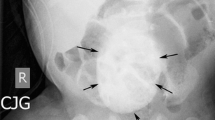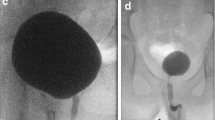Abstract
Background
There is heterogeneity in how pediatric voiding cystourethrography (VCUG) is performed. Some institutions, including our own, obtain a radiographic scout image prior to contrast agent instillation.
Objective
To demonstrate that the radiographic scout image does not augment VCUG interpretation or contribute management-changing information but nonetheless carries a non-negligible effective dose.
Materials and methods
We evaluated 181 children who underwent VCUG in 2012, with an age breakdown of less than 1 year (56 children), 1–5 years (66 children), 6–10 years (43 children) and 11–18 years (16 children), with a mean age of 4.0 years. We investigated patient demographics, clinical indication for the examination, scout image findings and estimated effective radiation dose, as well as overall exam findings and impression.
Results
No clinically significant or management-changing findings were present on scout images, and no radiopaque urinary tract calculi or concerning incidental finding was identified. Scout image estimated effective radiation dose averaged 0.09 mSv in children younger than 1 y, 0.09 mSv in children age 1–5, 0.13 mSv in children age 6–10 and 0.18 mSv in children age 11–18. Total fluoroscopy time per examination averaged 36.7 s (range 34.8-39.6 s for all age group averages). Evaluation of known or suspected vesicoureteral reflux (VUR) and urinary tract infection (UTI) were the most common clinical indications, stated in 40.9% and 37.0% of exams, respectively.
Conclusion
Although the estimated effective dose is low for VCUG radiographic scout images, this step did not augment VCUG interpretation or contribute management-changing information. This step should be omitted or substituted to further reduce dose in pediatric VCUG.



Similar content being viewed by others
References
Ward VL, Strauss KJ, Barnewolt CE et al (2008) Pediatric radiation exposure and effective dose reduction during voiding cystourethrography. Radiology 249:1002–1009
Sulieman A, Theodorou K, Vlychou M et al (2007) Radiation dose measurement and risk estimation for paediatric patients undergoing micturating cystourethrography. Br J Radiol 80:731–737
Smans K, Vaño E, Sanchez R et al (2008) Results of a European survey on patient doses in paediatric radiology. Radiat Prot Dosimetry 129:204–210
Council NR (2006) Health risks from exposure to low levels of ionizing radiation — BEIR VII. The National Academies Press, Washington, DC
Ward VL (2006) Patient dose reduction during voiding cystourethrography. Pediatr Radiol 36:168–172
Khong PL, Ringertz H, Donoghue V et al (2013) ICRP publication 121: radiological protection in paediatric diagnostic and interventional radiology. Ann ICRP 42:1–63
(2014) ACR-SPR practice parameter for the performance of voiding cystourethrography in children. Res. 13. http://www.acr.org/~/media/ACR/Documents/PGTS/guidelines/Voiding_Cystourethrography.pdf. Accessed 20 Oct 2014
Fefferman NR, Sabach AS, Rivera R et al (2009) The efficacy of digital fluoroscopic image capture in the evaluation of vesicoureteral reflux in children. Pediatr Radiol 39:1179–1187
Tapiovaara M, Siiskonen T (2008) PCXMC, a Monte Carlo program for calculating patient doses in medical X-ray examinations. STUK-A231, 2nd edn. Helsinki, Finland. http://www.stuk.fi/julkaisut_maaraykset/tiivistelmat/a_sarja/en_GB/stuk-a231/_files/80447058545737858/default/stuk-a231.pdf. Accessed 20 Oct 2014
10 Subcommittee on Urinary Tract Infection, Steering Committee on Quality Improvement and Management (2011) Urinary tract infection: clinical practice guideline for the diagnosis and management of the initial UTI in febrile infants and children 2 to 24 months. Pediatrics 128:595–610
Domina JG, Dillman JR, Adler J et al (2013) Imaging trends and radiation exposure in pediatric inflammatory bowel disease at an academic children’s hospital. AJR Am J Roentgenol 201:W133–140
Page M, Florescu C, Johnstone L et al (2013) Paediatric urological investigations — dose comparison between urology-related and CT irradiation. Pediatr Radiol 43:846–850
Lee R, Thomas KE, Connolly BL et al (2009) Effective dose estimation for pediatric voiding cystourethrography using an anthropomorphic phantom set and metal oxide semiconductor field-effect transistor (MOSFET) technology. Pediatr Radiol 39:608–615
Darling S, Sammer M, Chapman T et al (2011) Physician documentation of fluoroscopy time in voiding cystourethrography reports correlates with lower fluoroscopy times: a surrogate marker of patient radiation exposure. AJR Am J Roentgenol 196:W777–780
Lim R, Khawaja RD, Nimkin K et al (2013) Relationship between radiologist training level and fluoroscopy time for voiding cystourethrography. AJR Am J Roentgenol 200:645–651
Image Gently® (2014) Pause and pulse: voiding cystourethrography (VCUG) in children- tips for dose optimization. http://imagegently.dnnstaging.com/Portals/6/Radiologists/VCUGExaminationsFINAL.pdf. Accessed 09 April 2014
Lim R (2009) Vesicoureteral reflux and urinary tract infection: evolving practices and current controversies in pediatric imaging. AJR Am J Roentgenol 192:1197–1208
Acknowledgment
We would like to thank Jamie Daley R.T.(R) for her assistance with data collection.
Conflicts of interest
None
Author information
Authors and Affiliations
Corresponding author
Rights and permissions
About this article
Cite this article
Domina, J.G., Sanchez, R., Meesa, I.R. et al. Evaluation of pediatric VCUG at an academic children’s hospital: is the radiographic scout image necessary?. Pediatr Radiol 45, 855–861 (2015). https://doi.org/10.1007/s00247-014-3241-4
Received:
Revised:
Accepted:
Published:
Issue Date:
DOI: https://doi.org/10.1007/s00247-014-3241-4




